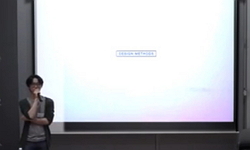본연구의목적은교정알고리즘을적용한3D프린팅발보조기가발변형 아동에미치는효과를알아보고자하였다. 연구방법은 평발 및발꿈치가쪽휜발로 진단받은 아동 20명을 대상으로 무작위분류후...
http://chineseinput.net/에서 pinyin(병음)방식으로 중국어를 변환할 수 있습니다.
변환된 중국어를 복사하여 사용하시면 됩니다.
- 中文 을 입력하시려면 zhongwen을 입력하시고 space를누르시면됩니다.
- 北京 을 입력하시려면 beijing을 입력하시고 space를 누르시면 됩니다.
교정 알고리즘을 적용한 3D프린팅 발 보조기가 발 변형 아동에 미치는 효과 = Effects of 3D Printing Foot Orthosis with Corrective Algorithm on Children with Foot Deformation
한글로보기https://www.riss.kr/link?id=T16536481
- 저자
-
발행사항
용인 : 용인대학교 일반대학원, 2022
-
학위논문사항
학위논문(박사) -- 용인대학교 일반대학원 , 물리치료학과 , 2022. 8
-
발행연도
2022
-
작성언어
한국어
- 주제어
-
발행국(도시)
경기도
-
형태사항
140 ; 26 cm
-
일반주기명
지도교수: 장우남
-
UCI식별코드
I804:41015-200000647226
- 소장기관
-
0
상세조회 -
0
다운로드
부가정보
국문 초록 (Abstract)
본연구의목적은교정알고리즘을적용한3D프린팅발보조기가발변형 아동에미치는효과를알아보고자하였다.
연구방법은 평발 및발꿈치가쪽휜발로 진단받은 아동 20명을 대상으로 무작위분류후연구군은3D프린팅발보조기를대조군은열가소성발보조기를 매일3시간씩12주간적용하였다.중재전·후정적균형매개변수,발물렁조직의 정량적 매개변수, 발 형태의 생체역학적 매개변수, 보조기사용자만족도평가를 측정하여그효과를알아보았다.
정적균형 매개변수의 면적 및 압력의 대칭성에 대한 집단내 비교는 윌콕슨 부호순위 검정을 실시하였고, 집단간 비교는 면적 및 압력의 대칭성, 보조기사용자만족도평가를 맨휘트니 U 검정으로 분석하였다. 그리고정적균형매개변수(면적비율및압력비율), 발물렁조직의정량적 매개변수(근긴장도, 강성도, 탄성도), 발 형태의 생체역학적 매개변수의 집단내 비교는 대응표본 T 검정을 집단간 비교는 독립표본 T 검정을 사용하여분석하였다.본연구의 결과는다음과같다.
첫째, 정적균형매개변수의집단내비교에서연구군은면적비율및대칭성과 압력비율대칭성에서유의미한차이를보였으며,집단간비교에서는면적비율 대칭성에서유의미한차이를보였다.둘째, 발 물렁조직의 정량적 매개변수에서는 집단내비교와집단간비교 모두유의미한차이를보이지는않았다.셋째, 발 형태의 생체역학적 매개변수에서 집단내 비교에서 연구군은 세로발활각도,안쪽세로발활각도,발뒤부각도,가로발활각도,발배뼈거친면높이, 발길이, 발너비, 발등길이, 발등높이, 발활높이지수에서 차이를 보였으며, 대조군은 가로발활각도, 발길이, 발등길이, 발등높이, 발활높이지수에서 유의미한 차이를 보였다. 집단간 비교에서는 발뒤부각도, 발등길이에서 유의미한차이를보였다.넷째, 보조기사용자만족도평가에서 중재 후 연구군은 총 12항목 중 ‘전문가서비스의 질’이 4.80점으로 가장 높았고, ‘설치의 용이성’이 가장 낮은 3.90점을 받았으며 항목 전체 만족도는 4.37점으로 나타났다. 대조군은 ‘전문가서비스의 질’이 3.80점으로 가장 높았고, ‘안락함’이 가장 낮은 2.80점을 받았으며 항목 전체 만족도는 3.34점으로 나타났다. 집단간 차이 비교에서 ‘규격’, ‘무게’, ‘사용의 용이성’, ‘안락함’, ‘효과성’, ‘서비스 전달’, ‘수리와 유지관리서비스’, ‘전문가서비스의 질’, ‘사후서비스’ 항목에서유의미한 차이를보였다.위의 결과로보아 교정알고리즘을적용한3D프린팅발보조기는 평발 및발꿈치가쪽휜발이 있는 발변형아동의 정적균형의기저면과발 형태 변화에 효과적이며,자세안정성과발형태교정에도움이될것이다.
다국어 초록 (Multilingual Abstract)
This study aimed to investigate the correctional effect of 3D-printed foot or thoses in children with foot deformities This study examined 20 children with talipes planus and talipes valgus, randomized into study and control groups. Children in the st...
This study aimed to investigate the correctional effect of 3D-printed foot or thoses in children with foot deformities This study examined 20 children with talipes planus and talipes valgus, randomized into study and control groups. Children in the study group were treated with 3D-printed foot or thoses, and children in the control group were treated with thermoplastic foot or thoses for 3 hours daily for a total of 12 weeks. The effects of each intervention were examined by measuring static balance parameters, quantitative parameters of foot soft tissue, biomechanical parameters of foot shape, and or thosis user satisfaction pre- and post-intervention. The area and pressure symmetry change in static balance parameters were analyzed via the Wilcoxon signed-rank test for intragroup comparisons. For intergroup comparison, differences in area and pressure symmetry change and orthosis user satisfaction were analyzed using the Mann–Whitney U test. Static balance parameters (area ratio and pressure ratio), quantitative parameters of soft tissue (muscle tone, stiffness, elasticity), and biomechanical parameters of foot shape were analyzed using a paired-sample t-test for intragroup comparisons and independent-samplet-test for intergroup comparisons. There sultsofthisstudy areas follows.First, intragroup comparison of static balance parameters showed a significant difference in area ratio, symmetry, and pressure symmetry change in the study group. There was a significant difference only in are asymme try differenceon intergroup comparison.
Second, there were no significant differences on both intragroup and intergroup comparisons for quantitative parameters of foot soft issue.
Third, intragroup comparison of biomechanical parameters of foot shape showed significant differences in the longitudinal arch angle, medial longitudinal arch angle, hind foot angle, transverse arch angle, navicular tube rosity height, foot length, foot width, instep length, instep height, and arch height index in the study group; the control group showed significant differences in transverse arch angle, foot length, instep length, instep height, and arch height index. Intergroup comparison showed significant differences in hind foot angle and instep length between the two groups.
Fourth, of the 12 items in the satisfaction evaluation of or thoses, ‘professional service’ had the highest score at 4.80, ‘adjustment’ had the lowest score at 3.90, and the overall satisfaction score was 4.37 on average post-intervention in the study group. In the control group, the item for ‘professional service’ had the highest score of 3.80, ‘comfort’ had the lowest score of 2.80, and the overall satisfaction score was 3.34. Intergroup comparisons showed significant differences in scoresfor‘dimension,’‘weight,’‘easy touse,’‘comfort,’‘effectiveness,’ ‘service delivery,’ ‘repair and servicing,’ ‘professional service,’ and ‘follow-up service.’
The results show that correctional 3D-printed foot or thosis was effective in changing the foot shape and basal plane of static balance of children with talipes planus and talipes valgus, helping correct foot shape and improve postural ability.
목차 (Table of Contents)
- Ⅰ. 서 론 1
- 1.연구의필요성 1
- 2.연구의목적 5
- 3.연구의가설 6
- 4.용어의정리 7
- Ⅰ. 서 론 1
- 1.연구의필요성 1
- 2.연구의목적 5
- 3.연구의가설 6
- 4.용어의정리 7
- 5.연구의제한점 8
- Ⅱ. 연구배경 9
- 1.발변형 9
- 2.발보조기 11
- 3.3D측정진단및 3D프린팅발보조기 12
- 4.3D프린팅보조기의 연구동향 13
- Ⅲ. 연구방법 16
- 1.연구대상 및기간 16
- 2.연구의틀 17
- 3.중재방법 19
- 1)3D프린팅발보조기 19
- 2)열가소성발보조기 29
- 4.평가도구 및방법 31
- 1)정적균형매개변수 31
- 2)물렁조직의 정량적매개변수 32
- 3)발형태의 생체역학적 매개변수 34
- 4)보조기사용자만족도평가 37
- 5.통계분석 38
- Ⅳ. 연구결과 39
- 1.대상자의일반적특성 39
- 2.정적균형매개변수 41
- 3.물렁조직의정량적 매개변수 45
- 4.발형태의생체역학적매개변수 50
- 5.보조기사용자만족도평가 56
- Ⅴ. 고 찰 59
- Ⅵ. 결 론 84
- Ⅶ. 참고문헌 86
- ABSTRACT 113
- 부 록(1) 퀘백 보조공학 사용자 만족도 평가도구 116
- 부 록 (2) 교정 알고리즘 특허 120
- 감사의 글 139













